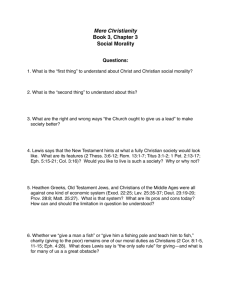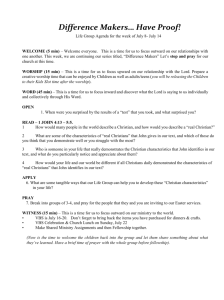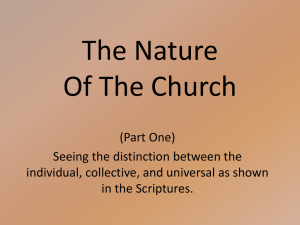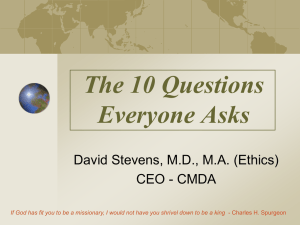The Early Christians - Midwest Theological Forum
advertisement
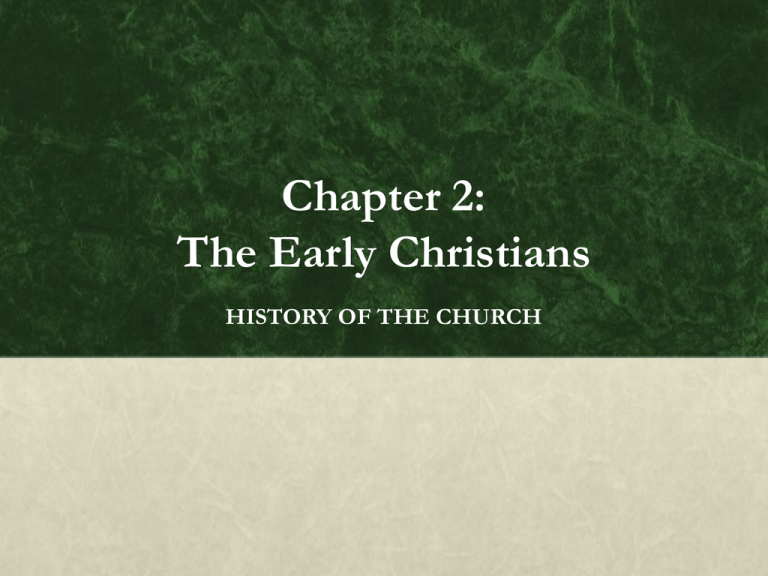
Chapter 2: The Early Christians HISTORY OF THE CHURCH 1. Beliefs and Practices (pp. 60–65) ANTICIPATORY SET Read the paragraphs “Christians are indistinguishable from…” through “Christians love those…” (p. 60). As you read or listen, keep in mind the following question: To what extent are modern conditions similar to those at the time of this letter? 1. Beliefs and Practices (pp. 60–65) BASIC QUESTIONS How did the early Church and the Roman world view each other? Was it legitimate for the early Church to have developed her beliefs and practices from the foundation of the Apostles? How were new members incorporated into the early Church? KEY IDEAS The early Christians were models of holiness, simplicity, and fraternity who set out to transform a hostile world. The beliefs and practices of Christianity emerged through centuries of theological, philosophical, cultural, and historical development under the guidance of the Holy Spirit in and through the Church. At first, converts were baptized as soon as they presented themselves. Later, the catechumenate developed to prepare adult converts for the demands of the Christian life during persecution. While infant and child Baptisms were practiced from the beginning, many later catechumens postponed Baptism until close to death. 1. Beliefs and Practices (pp. 60–65) FOCUS QUESTIONS The text states the body hates the soul because of the restrictions the soul puts on the body. What kind of restrictions does the soul demand of the body? The soul puts restrictions on physical pleasures and desires. Is there hatred today toward people who live by and advocate the Church’s teachings on chastity and married love? There is because these teachings often run opposite the desires, habits, and profits of those who live and advocate otherwise. Why did Christians flourish under persecution? People get stronger when they are being persecuted, which makes their lives more attractive. 1. Beliefs and Practices (pp. 60–65) GUIDED EXERCISE Complete a Think/Pair/Share on the following question: How does the excerpt from the Epistle to Diognetus illustrate the saying, “Christians are in the world but not of the world”? 1. Beliefs and Practices (pp. 60–65) FOCUS QUESTIONS What does it mean to say that Christians refused to expose their children? Exposure was a way the Romans killed unwanted babies, leaving them in the countryside to die, i.e., exposed to the elements. What does this statement regarding Christians imply about Roman society: “They share their meals, but not their wives”? Roman society had a low moral level. 1. Beliefs and Practices (pp. 60–65) FOCUS QUESTIONS To what does “the ancient and holy but often persecuted tradition” refer? This refers to Judaism, the precursor to Christianity. What is worth imitating about the early Christians? They were models of holiness, simplicity, and fraternity. What radically new vision of human life did early Christians offer the world? God had come to earth, shown people how to live the New Law of Love, and won victory over death. 1. Beliefs and Practices (pp. 60–65) GUIDED EXERCISE Work with a partner to answer the following review questions: What was the effect of the Council of Jerusalem? What was the effect of the destruction of the Temple? 1. Beliefs and Practices (pp. 60–65) FOCUS QUESTIONS When was the catechumenate restored? It was restored by the Second Vatican Council in 1965. What was Tertullian’s argument against infant Baptism? Though he did not deny its validity, Tertullian believed Baptism should be delayed to avoid the danger of profaning Baptism by youthful sins. What was Origen’s argument in favor of infant Baptism? Origen recommended cleansing the guilt associated with Original Sin as early as possible. 1. Beliefs and Practices (pp. 60–65) FOCUS QUESTIONS Why did St. Augustine wish he had been baptized as a child? He wished he could have cared for his soul more diligently with the help of Christian friends. Why did St. Augustine think his mother delayed his Baptism? He thought his mother foresaw waves of temptation as he grew out of childhood and so did not have him baptized. 1. Beliefs and Practices (pp. 60–65) FOCUS QUESTIONS When a person is in danger of death, who can baptize? Anyone, even a non-baptized person, can baptize. What is the Baptism of Blood? This refers to a catechumen who is martyred before he or she can be baptized with water. Such a person receives the graces of Baptism through that martyrdom. 1. Beliefs and Practices (pp. 60–65) FOCUS QUESTIONS Why did some people delay Baptism until they were on their deathbeds? He or she could sin during life—whether planning to or not—and still enter Heaven. Why is delaying Baptism until the end of life a bad idea? License to sin contradicts the Spirit of Christ. Delaying Baptism limits the ability to live a Christian life because of a lack of the grace that helps Christians live a moral life. Finally, it is dangerous because nobody never knows the hour of his or her death. 1. Beliefs and Practices (pp. 60–65) FOCUS QUESTIONS Why is Baptism important? Christ commanded his Apostles to baptize those who were made disciples. It is the only known way to enter the Kingdom of God. What baptism did Christ receive? Christ received a baptism of repentance from St. John the Baptist. Extension: Christ received St. John’s baptism as an example to others. He was without sin and thus had no need for baptism. What is the difference between a baptism of repentance and the Sacrament of Baptism? A baptism of repentance helps a person realize the need to repent and be forgiven of sins; this may prepare a person for the Sacrament of Baptism, which forgives sins. 1. Beliefs and Practices (pp. 60–65) GUIDED EXERCISE Work with a partner to perform a paragraph shrink on the excerpt from Crossing the Threshold of Hope (p. 89) about Christianity as the great action of God. 1. Beliefs and Practices (pp. 60–65) FOCUS QUESTIONS Why was the catechumenate instituted? It provided an organized program of instruction for those converting to Christianity, which was necessary because Christians could be overwhelmed by persecution if not formed well. When did Baptism usually occur? Catechumens were baptized at the Easter Vigil, which commemorates the Resurrection of Christ, or on the Saturday before Pentecost, which recalls the descent of the Holy Spirit. Why did the catechumenate fall into disuse? By the Medieval period the persecutions had ended and most new members of the Church were the children of Christian parents. 1. Beliefs and Practices (pp. 60–65) GUIDED EXERCISE Complete a Think/Pair/Share to list at least three doctrinal and at least three practical reasons the Church advocates infant Baptism. 1. Beliefs and Practices (pp. 60–65) GUIDED EXERCISE Complete a Think/Pair/Share about whether St. Augustine agreed with Tertullian or Origen when it came to his own Baptism. 1. Beliefs and Practices (pp. 60–65) HOMEWORK ASSIGNMENT Study Question 1 (p. 91) Workbook Questions 1–14 Read “Agape and the Eucharist” through “Priesthood” (pp. 65–72) 1. Beliefs and Practices (pp. 60–65) CLOSURE Free write for five minutes on the following questions: Why do you think the Church recommends infants be baptized instead of waiting until the person can choose for him- or herself? Why is it not a good idea to delay Baptism until a person is on his or her deathbed? 1. Beliefs and Practices (pp. 60–65) ALTERNATIVE ASSESSMENT Write an in-class, graded essay on how the Church’s practice of the Sacrament of Baptism developed over time. 2. Worship and the Hierarchy (pp. 65–72) ANTICIPATORY SET Review the sidebar “Christian Symbols” (p. 70), and then discuss the following questions: Why is a cross is the most widespread Christian symbol? What is the significance of tracing a cross on one’s body? Why do some people touch their first three fingers together when making the sign of the cross? Why is a fish a Christian symbol? Why is an anchor a Christian symbol? 2. Worship and the Hierarchy (pp. 65–72) BASIC QUESTIONS What did the early Church believe about the Eucharist? Who held authority in the early Church? KEY IDEAS The early Christians believed in the Real Presence in the Eucharist. Christ made St. Peter the visible head of the Church on earth, and this authority was handed on to his successors, the Bishops of Rome; the bishops are the successors of the Apostles. 2. Worship and the Hierarchy (pp. 65–72) FOCUS QUESTION What was the Agape? The first Christians celebrated the Eucharist in a similar manner to the Last Supper: a ritual meal at the end of which the bishop consecrated bread and wine. The early Christians called the first part the dinner “Agape,” or love feast. 2. Worship and the Hierarchy (pp. 65–72) FOCUS QUESTIONS Why did St. Paul criticize the way the Corinthians celebrated the Agape? Some people were going hungry and others were getting drunk. What was the fate of the Agape? In order to avoid impiety and denigration of the Eucharist, the Agape and the Eucharist were separated, with the Agape being moved to the evening. The Agape was later discontinued. 2. Worship and the Hierarchy (pp. 65–72) GUIDED EXERCISE Complete a Think/Pair/Share about the Eucharistic Liturgy in the early Church and the modern-day Mass: List at least two ways they are similar and at least two ways they are different. 2. Worship and the Hierarchy (pp. 65–72) FOCUS QUESTIONS What does the word “eucharist” mean? It means “thanksgiving.” What did the early Christians believe happened during the Eucharist? All the early documents indicate they believed Christ was truly present in the Eucharist under the appearance of bread and wine. 2. Worship and the Hierarchy (pp. 65–72) FOCUS QUESTION What does St. Ambrose say to those who argue it is impossible or unreasonable for the bishop or priest to change bread and wine into the Body and Blood of Christ? The blessing, or words of consecration—not the bishop or priest— change the nature of the bread and wine. Since God has the power to create bread and wine from nothing and give them their original natures, he certainly also has the power to change the natures of these things. 2. Worship and the Hierarchy (pp. 65–72) GUIDED EXERCISE Complete a Think/Pair/Share about many Protestants’ disbelief in the Real Presence, that is, Jesus Christ being truly present in the Eucharist under the appearance of bread and wine: How is such Protestants’ belief different from that of the early Christians and the Fathers of the Church? 2. Worship and the Hierarchy (pp. 65–72) GUIDED EXERCISE Search the Internet for a virtual tour of the catacombs. View their maps, photos, and descriptions. 2. Worship and the Hierarchy (pp. 65–72) FOCUS QUESTIONS Why were private homes and catacombs used for liturgical services? Christian church buildings were generally not permitted. What are catacombs? They are underground burial places and shrines. 2. Worship and the Hierarchy (pp. 65–72) FOCUS QUESTIONS Where have catacombs been found? The most impressive are in Rome, but they have also been discovered in Italy, France, and Northern Africa. What are loculi, cubicula, and crypts? Loculi are individual burial tombs. Cubicula are small rooms where families could be buried together. Crypts are larger rooms turned into small churches that contain the remains of Popes or martyrs. 2. Worship and the Hierarchy (pp. 65–72) FOCUS QUESTIONS Why did the early Christians bury their dead rather than cremate them? They believed in the resurrection of the body. Extension: The desire to be buried together showed their strong sense of community. Why did the early Christians baptize and celebrate the Eucharist in the catacombs? It was a place of refuge during periods of persecution. 2. Worship and the Hierarchy (pp. 65–72) GUIDED EXERCISE Locate the seven churches of the Book of Revelation (chapters 1–3) using the map “Christian Churches in Asia Minor” (p. 68). 2. Worship and the Hierarchy (pp. 65–72) GUIDED EXERCISE Complete a Think/Pair/Share using the map “Christian Communities by AD 300” (p. 69), using the following prompts: What two regions of the Roman Empire had a Christian majority? Identify two cities in which a minority of the population was Christian. Identify one province in which very few people were Christian. 2. Worship and the Hierarchy (pp. 65–72) GUIDED EXERCISE Search the Internet and take a virtual tour of the cave church of St. Peter’s Grotto, one of the earliest in the world, carved about AD 50. 2. Worship and the Hierarchy (pp. 65–72) FOCUS QUESTIONS Why were Wednesdays and Fridays adopted as days of fasting and penance? Wednesday may have been adopted because Judas betrayed Christ on a Wednesday. Friday was adopted because Christ gave up his life on the Cross on a Friday. How is a day measured in Jewish tradition? The day begins at sunset and lasts until sunset the next day. 2. Worship and the Hierarchy (pp. 65–72) FOCUS QUESTIONS Why did the chief day of worship for Christians shift from Saturday to Sunday? The Sabbath was the day of rest; the first Christians—converts from Judaism—continued to observe the Sabbath. Soon, however, Sunday, the first day of the week, became the day of worship as the day Christ rose from the dead and the day of Pentecost. The first day of the week thus represented the first day of God’s creation and the “eighth day,” the beginning of the new creation. 2. Worship and the Hierarchy (pp. 65–72) GUIDED EXERCISE Repeat or modify the Anticipatory Set (p. 65) about Christian Symbols. 2. Worship and the Hierarchy (pp. 65–72) FOCUS QUESTIONS Whom did Christ make the visible head of the Church on earth? He made the Apostle St. Peter the visible head of the Church on earth. Which two Popes during the first five centuries were most instrumental in the development of the power of the papacy? Pope St. Leo the Great maintained Church governance in Rome when political power had shifted to the East. Pope St. Gelasius I was the first to use the title “Vicar of Christ.” 2. Worship and the Hierarchy (pp. 65–72) FOCUS QUESTION What three historical sources in the early Church support the Bishop of Rome as the supreme authority in the Church? Pope St. Clement I settled a controversy within the Church in Corinth. St. Ignatius of Antioch affirmed deferential obedience to the Bishop of Rome. St. Irenæus stressed traditional structures in the Church such as the papacy. 2. Worship and the Hierarchy (pp. 65–72) GUIDED EXERCISE Read aloud two passages in Scripture in which Christ confers on St. Peter his role as visible head of the Church on earth: Matthew 16:13–20: Christ gives Simon the name Peter (Rock) and says he is the rock upon whom he will build his Church with the power to loose and bind. John 21:15–17: Christ reinstates St. Peter after his betrayal, confirming his role as chief shepherd. 2. Worship and the Hierarchy (pp. 65–72) CLOSURE Some people have claimed that the papacy was invented by the Catholic Church. Work with a partner to answer the following question in writing: What evidence from Sacred Scripture and early Church history demonstrates the primacy of the successors of St. Peter was instituted by Christ and always believed by the Church? 2. Worship and the Hierarchy (pp. 65–72) HOMEWORK ASSIGNMENT Study Questions 2–7 (p. 91) Workbook Questions 15–37 Read “Monotheism” through “Money Matters” (pp. 73–78) 2. Worship and the Hierarchy (pp. 65–72) ALTERNATIVE ASSESSMENT Write a paragraph in response to the question below. You should support your answer with at least one quote from Scripture and at least one from an early Church Father. What did the early Church believe about the Eucharist? 3. The Canon of Scripture and Christians in Society (pp. 73–78) ANTICIPATORY SET Read silently Isaiah 53. Identify prophecies that were fulfilled in the Passion and Death of Christ. 3. The Canon of Scripture and Christians in Society (pp. 73–78) BASIC QUESTIONS How was the canon of Sacred Scripture formed? How did the early Christians respond to the social conditions of the Roman Empire? KEY IDEAS The decision of which books form the canon of Sacred Scripture was made over many centuries and was decided by the Magisterium of the Church. The early Christians believed that slaves have equal dignity to freemen; violence should be rejected in favor of love for one’s enemy, though selfdefense and national defense were permitted; loyal citizenship and obedience should be given to just laws; and the use of material possessions and work are intended to serve the needs of others, especially the needy. 3. The Canon of Scripture and Christians in Society (pp. 73–78) FOCUS QUESTION How did the early Christians’ monotheistic belief put them in conflict with the Roman culture in which they lived (cf. p. 73)? They could not make sacrifices to the pagan gods nor take part in their public rituals. How was Christianity similar to Judaism with respect to its relationship to the larger world? Both monotheistic religions were surrounded by polytheistic cultures. 3. The Canon of Scripture and Christians in Society (pp. 73–78) GUIDED EXERCISE Work with a partner to perform a paragraph shrink on the paragraph, “By the early…” (pp. 73–74). 3. The Canon of Scripture and Christians in Society (pp. 73–78) FOCUS QUESTION How was the canon of Scripture formed in the early Church? The early Church accepted some books universally while it was less certain about others. A definitive canon was declared by a synod of bishops in Rome AD 382. Extension: The formation of the canon of Scripture was complex and took many centuries. It is important to emphasize that the Scriptures did not define the nature of the early Church; rather, the Church defined which writings were inspired. 3. The Canon of Scripture and Christians in Society (pp. 73–78) FOCUS QUESTION How did the early Christians see the Sacred Scriptures with respect to Sacred Tradition? The Scriptures were venerated as the Word of God and extremely important to the life of the Church. However, they were not the sole source of the teachings of Christ, the Deposit of Faith. Sacred Scripture is a vital and central part of Sacred Tradition, which is expressed in Christian literature, liturgical practice, and pronouncements of the Church. Extension: Sacred Tradition includes what was written and what was not written, and it is interpreted authentically by the Magisterium of the Church. 3. The Canon of Scripture and Christians in Society (pp. 73–78) GUIDED EXERCISE Complete a Think/Pair/Share using the following question: If you were a slave in the Roman Empire, how might you feel about Christianity? 3. The Canon of Scripture and Christians in Society (pp. 73–78) FOCUS QUESTION Why might the early Christians have rejected the story about the Christ child getting angry and turning his playmate into a frog? Christ using his divine powers to exact revenge goes against what they knew about him and his teachings. Extension: This and other stories in the same narrative do not even reach the level of the Old Testament precept of an eye for an eye. 3. The Canon of Scripture and Christians in Society (pp. 73–78) FOCUS QUESTION What role did the Old Testament play in the early Church? Though the Church did not require her members to follow the Mosaic Law, the early Christians held the Old Testament to be divinely revealed. The early Church maintained that the prophecies of the Old Testament foreshadowed the fullness of truth in Christ, so they revered deeply and studied the Old Testament carefully. The early Christians also used the Old Testament—especially the Psalms—as a source of prayers. 3. The Canon of Scripture and Christians in Society (pp. 73–78) GRAPHIC ORGANIZER Complete the following table about the conditions to wage a just war (cf. p. 76). 3. The Canon of Scripture and Christians in Society (pp. 73–78) 3. The Canon of Scripture and Christians in Society (pp. 73–78) GUIDED EXERCISE Perform a Focused Reading of the paragraph, “The Roman state…” (p. 77), using the following question: Which laws did the early Christians obey, and which did they refuse to obey? 3. The Canon of Scripture and Christians in Society (pp. 73–78) FOCUS QUESTIONS How prevalent was slavery within the Roman Empire? During the first century AD, about one-fourth of the population of the Italian peninsula was slaves. How was Jewish slavery different from Roman slavery? Under Roman law, some slaves were chattel—property with which the master could do whatever he willed—whereas, in Jewish law, merciful treatment was required, the dignity of the slave and his labor were recognized, and slaves could gain their freedom in a shorter time. 3. The Canon of Scripture and Christians in Society (pp. 73–78) FOCUS QUESTIONS Why did the early Church not demand an end to slavery? The early Church had no power to do anything about slavery. How is slavery incompatible with Christianity? The Gospel implicitly condemns slavery as a grave offense against humanity and Christ’s call to love as he loved. Slavery undermines the essential dignity of the human person, who should never be used as a means only. 3. The Canon of Scripture and Christians in Society (pp. 73–78) FOCUS QUESTIONS How did the early Christians treat slaves? Slaves were treated as equal in dignity to freemen. How did St. Paul urge slaves and masters to behave? Slaves should give sincere obedience to their masters as if serving the Lord. Masters should do good to their slaves and not threaten them, knowing that their Master in Heaven holds each to be equal. 3. The Canon of Scripture and Christians in Society (pp. 73–78) FOCUS QUESTIONS How did the early Church view labor, service, and obedience? These were goods in themselves; Christ was a carpenter, he came to serve, and he was obedient to the Father even unto death. What slavery did St. Paul definitely encourage? He encouraged slavery to Christ. 3. The Canon of Scripture and Christians in Society (pp. 73–78) FOCUS QUESTIONS What is the relationship between slavery and the early Popes? The three Popes after St. Peter (Sts. Linus, Cletus, and Clement) had been slaves. What does Christ teach is the right response to an enemy? One must respond nonviolently, love his or her enemies, and pray for all enemies. 3. The Canon of Scripture and Christians in Society (pp. 73–78) GUIDED EXERCISE Complete a Think/Pair/Share using the following question: What was the attitude of the early Christians toward the use of material resources? 3. The Canon of Scripture and Christians in Society (pp. 73–78) FOCUS QUESTION What is the just war theory? This articulates the conditions under which war may be waged. 3. The Canon of Scripture and Christians in Society (pp. 73–78) CLOSURE Discuss the following question: From time to time it is announced that archaeologists have discovered a “new, ancient Gospel” that challenges people’s understanding of Christ and his life and teachings. What would the early Christians have said about such writings? 3. The Canon of Scripture and Christians in Society (pp. 73–78) HOMEWORK ASSIGNMENT Study Questions 8–14 (p. 91) Practical Exercises 1–3 (p. 91) Workbook Questions 38–55 Read “Sexual Ethics: Abortion and Contraception” through “Church Fathers on Contraception” (pp. 78–81) 3. The Canon of Scripture and Christians in Society (pp. 73–78) ALTERNATIVE ASSESSMENT Write a short essay using the question from the Closure activity, to be collected for a quiz grade. 4. Christians in Society (continued) (pp. 78–81) ANTICIPATORY SET Read aloud the excerpt from The Apostolic Tradition (Additional Resources, p. 86). 4. Christians in Society (continued) (pp. 78–81) BASIC QUESTIONS What did the early Church believe about abortion and contraception? What was the attitude of the early Church toward women? KEY IDEAS The early Christians had a high regard for chastity and virginity and believed sexual relations were for marriage and the procreation of children; they condemned abortion and contraception. The early Christians considered women as equal in dignity to men, which was an elevated status compared to the surrounding Roman culture. 4. Christians in Society (continued) (pp. 78–81) FOCUS QUESTIONS What did the early Church teach about abortion, infanticide, and contraception? The early Church rejected these practices completely. Why did the early Church reject abortion and infanticide? Abortion and infanticide are grave violations of the dignity of the human person and violate the Fifth Commandment. 4. Christians in Society (continued) (pp. 78–81) FOCUS QUESTION Why did the early Church reject contraception? Sexual relations within the context of marriage are good, and one of their intrinsic purposes is procreation. The use of contraception is immoral because it separates the act from one of its intrinsic purposes. 4. Christians in Society (continued) (pp. 78–81) GUIDED EXERCISE Read aloud the Catechism, no. 2271 (p. 92), and then discuss the teachings of the early Church. 4. Christians in Society (continued) (pp. 78–81) FOCUS QUESTIONS In what ways did the early Church show great respect for women? Christianity taught that men and women are equal in dignity. In addition, the greatest human person who ever lived was the Blessed Virgin Mary. What roles did women play in the early Church? Women spread the Gospel by ordinary and extraordinary means and suffered equal persecution. What did the early Christians consider the hallmarks of the Christian family? While pagan family life could be brutal to women and children, the 4. Christians in Society (continued) (pp. 78–81) GUIDED EXERCISE Work with a partner to perform a paragraph shrink on Tertullian’s To His Wife (p. 89). 4. Christians in Society (continued) (pp. 78–81) GUIDED EXERCISE Complete a Think/Pair/Share using the Catechism, no. 2334 (p. 92), and the following question: In the history of Western Christian culture, why has it often seemed men considered women less than equals? 4. Christians in Society (continued) (pp. 78–81) FOCUS QUESTIONS What was St. Epiphanius’s criticism of the Gnostics? They have sex not to conceive children but to satisfy their lust only. What methods of contraception did people know in the early Church? Mentioned here are medicines (poisons inducing sterility and abortion) and incantations. 4. Christians in Society (continued) (pp. 78–81) FOCUS QUESTION What did St. John Chrysostom mean when he said, “From drunkenness comes fornication, from fornication adultery, from adultery murder”? Culturally, men who drink to excess tend to fornicate with prostitutes, which is adultery for those who are married. Because this act may result in conception, the prostitute practices the prevention or abortion of new life. 4. Christians in Society (continued) (pp. 78–81) CLOSURE Free write for five minutes in response to the following question: What is the connection between the early Church’s belief in the equality of the dignity of women and men and her prohibition of practices like abortion, infanticide, contraception, prostitution, and concubinage? 4. Christians in Society (continued) (pp. 78–81) HOMEWORK ASSIGNMENT Study Questions 15–16 (p. 91) Workbook Questions 56–62 Read “Important Writings of the Early Christian Period” through “Conclusion” (pp. 82–87) 4. Christians in Society (continued) (pp. 78–81) ALTERNATIVE ASSESSMENT Complete the Practical Application in the Student Workbook (p. 44) either individually or in a small group. 5. Writings and Martyrdom (pp. 82–88) ANTICIPATORY SET Free write for five minutes in response to this prompt: Imagine you are a Christian living in the Roman Empire and your best friend, who is a pagan, confronts you, very upset. He or she has just been told that Christians have underground ceremonies during which they eat human flesh and drink human blood. 5. Writings and Martyrdom (pp. 82–88) BASIC QUESTIONS What were the important writings of the early Christian era, and why are they important? Why did the early Christians venerate the martyrs? KEY IDEAS The Apostolic Fathers are important witnesses to the Faith due to their close proximity to the Apostles and the communities the Apostles established. Some Apostolic Fathers wrote apologetics to explain and defend the Faith against Jewish, Gnostic, and pagan attacks. The martyrs were the greatest testimony to the truth and power of Christianity. 5. Writings and Martyrdom (pp. 82–88) FOCUS QUESTIONS What does the title “Apostolic Father” signify? This refers to a religious writer who lived just after the Apostles and had a direct link to an Apostle or a community established by one of the Apostles. Who are the most important Apostolic Fathers from Rome and Antioch? Pope St. Clement I was from Rome, and St. Ignatius was from Antioch. Why are the writings of the Apostolic Fathers not included in Sacred Scripture? The Church never recognized them as divinely inspired, though they were held in great esteem and some were written before some of the inspired 5. Writings and Martyrdom (pp. 82–88) GUIDED EXERCISE Perform a Focused Reading of the paragraph and quote, “As previously mentioned… obey His commandments” (pp. 82–83), using the following question: Why is St. Justin Martyr’s Dialogue with Trypho considered an apologetic against Jewish objections to Christianity? 5. Writings and Martyrdom (pp. 82–88) FOCUS QUESTIONS What is apologetics? This branch of theology defends and explains the Christian religion against objections. When was the first of the four major periods of apologetical writings? The first dates from the dawn of Christianity to the fall of the Roman Empire. What struggle was undertaken by the apologetical writers of this first period? The objectors at this time were Jews, Gnostic heretics, and pagans within Roman society. 5. Writings and Martyrdom (pp. 82–88) FOCUS QUESTIONS Why is Tertullian considered the Father of Latin theology? He was the first great apologist of the Church who wrote in Latin. What is the character of Tertullian’s writings? Tertullian argued that Christians posed no threat to the empire. His style was brilliant, and he did not mind angering his readers. 5. Writings and Martyrdom (pp. 82–88) FOCUS QUESTION What heretical ideas did Tertullian hold later in life? He joined the heretical Montanist sect, rejecting the teaching authority of the Church in favor of so-called prophetic outpourings of the Holy Spirit. Extension: The Montanists believed the new, heavenly Kingdom was going to begin in Pepuza, a small town in Phrygia. The Montanists also denied certain grave sins could be forgiven by the Church. Tertullian later split from the Montanists to found his own sect. 5. Writings and Martyrdom (pp. 82–88) GRAPHIC ORGANIZER Work with a partner to complete the following table about what pagans believed about the early Christians (cf. pp. 83–84). 5. Writings and Martyrdom (pp. 82–88) 5. Writings and Martyrdom (pp. 82–88) GRAPHIC ORGANIZER Work with a partner to complete the following table about the Didache (cf. p. 89). 5. Writings and Martyrdom (pp. 82–88) 5. Writings and Martyrdom (pp. 82–88) FOCUS QUESTIONS Why were St. Hippolytus’s writings forgotten in the West for some time? He was probably the most important theologian in the Roman Church during the third century, but, because he wrote in Greek, he was forgotten. What part of St. Hippolytus’s writings are best known today? The Eucharistic prayer he records in The Apostolic Tradition is the basis of Eucharistic Prayer II in the Mass in the Latin Rite. 5. Writings and Martyrdom (pp. 82–88) FOCUS QUESTION How is St. Hippolytus both a heretic and a saint? St. Hippolytus broke with Pope St. Callistus, and Hippolytus’s followers elected him Pope in opposition. Both men were persecuted under Emperor Maximin. St. Hippolytus was later reconciled with Pope St. Pontian before his martyrdom. What is a martyr? Greek for “witness,” a martyr has borne the highest witness to Christ by dying for the Faith. 5. Writings and Martyrdom (pp. 82–88) FOCUS QUESTIONS What effect did the martyrs have on Christians and pagans? The martyrs strengthened and edified other Christians and affected many pagans deeply—such as magistrates and the executioners—who witnessed the courage, serenity, and joy with which they died. Why were martyrs venerated by the early Christians? A martyr participates in the sufferings of Christ. The Christian community saw martyrdom as a grace and gift from God in which the theological virtues of faith, hope, and charity reach their highest levels. 5. Writings and Martyrdom (pp. 82–88) HOMEWORK ASSIGNMENT Study Questions 17–20 (p. 91) Workbook Questions 63–80 Workbook Vocabulary 1–12 5. Writings and Martyrdom (pp. 82–88) CLOSURE Tell the story of a twentieth-century Catholic martyr. 5. Writings and Martyrdom (pp. 82–88) ALTERNATIVE ASSESSMENT Take time to update your timeline. Be sure to include at least the following: St. Ignatius of Antioch (ca. 35–107) Pope St. Clement I (88–97) St. Justin Martyr’s Dialogue with Trypho (ca. 150) Tertullian (160–225) St. Hippolytus (170–236) St. Cecilia’s martyrdom (230) THE END
